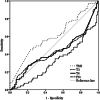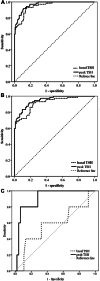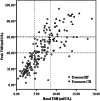Role of thyrotropin-releasing hormone test in re-evaluation of congenital hypothyroidism
- PMID: 25002375
- PMCID: PMC11916237
- DOI: 10.1016/j.kjms.2014.04.005
Role of thyrotropin-releasing hormone test in re-evaluation of congenital hypothyroidism
Abstract
The thyrotropin-releasing hormone (TRH) test is useful for differentiating central and primary hypothyroidism, and is also valuable for diagnosing hypothyroidism. The threshold of the TRH test is usually set at 10-40 mIU/L. However, some experts are of the opinion that the TRH test has a limited role in evaluating hypothyroidism because of the clinical application of the new-generation thyroid-stimulating hormone (TSH) assay. We reviewed a case series to analyze the clinical use of the TRH test in the re-evaluation of congenital hypothyroidism. In total, data on 228 children with eutopic thyroid glands and neonatal hyperthyrotropinemia under levothyroxine replacement were collected. Basal TSH levels were measured and the TRH test was performed at the age of 3 years for re-evaluation of congenital hypothyroidism, and statistical analysis was performed. All of the patients were followed up to avoid over- or under-treatment. At the age of 3 years, 31.6% of the patients still had hypothyroidism. There was no significant difference between basal TSH level and TRH test in the diagnosis of hypothyroidism (p = 0.23). The negative predictive value of the basal TSH level was 100%, however, the positive predictive value was only 43.6%. When the TSH level was near the upper limit of the normal range (4.5-8.5 mIU/L), the TRH test result had a better correlation with hypothyroidism than the basal TSH level (p = 0.03). The threshold of the TRH test set at 60 mIU/L had the greatest area under the curve, with a negative predictive value of 95.2% and a positive predictive value of 80.2%. Neonatal hyperthyrotropinemia was a risk factor for hypothyroidism. We suggest that the TRH test should be administered in children with a basal TSH value near the upper limit of the normal range, and the threshold of the TRH test should be set at 60 mIU/L.
Keywords: Congenital hypothyroidism; Neonatal hyperthyrotropinemia; Thyrotropin-releasing hormone test.
Copyright © 2014. Published by Elsevier B.V.
Figures




Similar articles
-
The Role of Thyrotropin-Releasing Hormone Stimulation Test in Management of Hyperthyrotropinemia in Infants.J Clin Res Pediatr Endocrinol. 2015 Sep;7(3):211-6. doi: 10.4274/jcrpe.1985. J Clin Res Pediatr Endocrinol. 2015. PMID: 26831555 Free PMC article.
-
Role of the thyrotropin-releasing hormone stimulation test in diagnosis of congenital central hypothyroidism in infants.J Clin Endocrinol Metab. 2008 Feb;93(2):410-9. doi: 10.1210/jc.2006-2656. Epub 2007 Nov 13. J Clin Endocrinol Metab. 2008. PMID: 18000095
-
Thyroid-stimulating hormone, prolactin, and growth hormone response to thyrotropin-releasing hormone in treated children with congenital hypothyroidism.Pediatr Res. 1985 Oct;19(10):1037-9. doi: 10.1203/00006450-198510000-00018. Pediatr Res. 1985. PMID: 3932951
-
Central Hypothyroidism Due to a TRHR Mutation Causing Impaired Ligand Affinity and Transactivation of Gq.J Clin Endocrinol Metab. 2017 Jul 1;102(7):2433-2442. doi: 10.1210/jc.2016-3977. J Clin Endocrinol Metab. 2017. PMID: 28419241 Free PMC article. Review.
-
The clinical impact of the thyrotropin-releasing hormone test.Thyroid. 1998 Oct;8(10):903-8. doi: 10.1089/thy.1998.8.903. Thyroid. 1998. PMID: 9827657 Review.
References
-
- American Academy of Pediatrics , Rose S.R., Section on Endocrinology and Committee on Genetics , American Thyroid Association , Brown R.S., Public Health Committee , et al. Update of newborn screening and therapy for congenital hypothyroidism. Pediatrics. 2006; 117: 2290–2303. - PubMed
-
- Faglia G.. The clinical impact of the thyrotropin‐releasing hormone test. Thyroid. 1998; 8: 903–908. - PubMed
MeSH terms
Substances
LinkOut - more resources
Full Text Sources
Other Literature Sources

